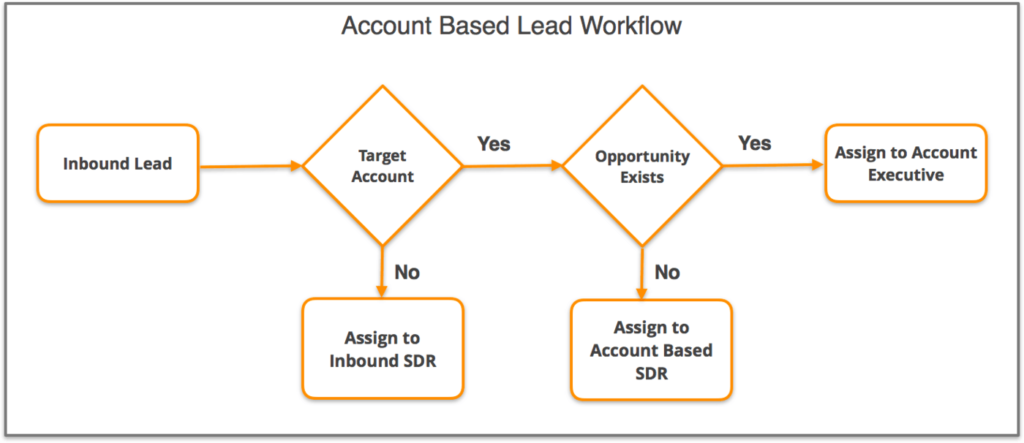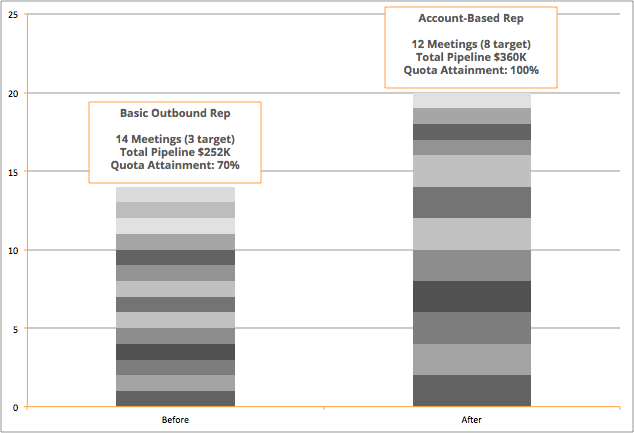In mid 2015, Datahug began the process of transitioning its sales team to an Account-Based Selling model. We know our market well, and wanted to capitalize on this understanding as fast as possible. The primary goal was to minimize friction in our pipeline by focusing on prospects that would get the most value from our product, while requiring the shortest sales cycle to close.
Selecting Target Accounts
To start, we had to identify what this sort of customer looks like. For Datahug, this means tech-forward North American companies with between 200 and 2000 employees, a sales team of 25 people or more, an average sales cycle of 45 days or longer, and average deal size of $30,000.
Next we had to create the list of Accounts we’d prioritize over general prospecting. There are a few places to source this data. We’ve been in business for a while and are transitioning to an Account-Based selling model from a more conventional inside sales setup, so we had an entire CRM of information to pick through.
We’ve also used Linkedin, Crunchbase and ZoomInfo, all great resources for market data. If these aren’t enough, you can always resort to buying information from proprietary databases that sell lists based on your criteria, but this is not as cost-effective or targeted as other methods.
Once we segmented our target Accounts from the rest of our pipeline, it came time to build a process for addressing them.
Re-engineering the Workflow
Prior to making the transition to Account-Based selling, we were operating a typical inside sales model, wherein SDRs would conduct prospecting to set meetings, which would be taken by our AEs. We shifted the order of operations in our Account-Based model so that Sales Ops starts the workflow.
Sales Ops selects priority Accounts from the target list, which are given to the SDR team. The SDRs then prospect into these Accounts, but in a much more deliberate, high touch manner than we previously used for outreach. More on that later.
Wrestling with Salesforce
One of the first challenges we encountered when adopting an Account-Based selling model was how to reflect our work in Salesforce. Due to the way Accounts, Contacts, Opportunities and Leads are recognized and related, it isn’t immediately obvious how to automate activity tracking or which leads can be confidently followed up on by the SDR team without duplicating the efforts of the AE team. So Salesforce does not natively support the Account-Based selling model efficiently.

When a new Lead comes in, Salesforce has no native functionality to automatically associate it with an Account. Unless you’re using 3rd party software, you have to go through and manually convert Leads to Contacts so that they’re visible in Account view.
But in an Account-Based Selling model, you want to respond to target Accounts as soon as they engage with your marketing. So any time spent slogging through new Leads and sorting them into Contacts for Accounts or merging duplicates is time wasted. Anyone trying to run an Account-Based sales team from Salesforce will run into this issue.
[Tweet “In ABS, you want to respond to target Accounts as soon as they engage w/ marketing.”]
There are a couple ways this can play out. It’s all too common that sales teams simply accept this state of affairs and press on despite the lack of visibility. The presales team will continue working from Leads, and the AE team from Contacts. Each team will have a list of the priority Accounts, so in theory, everyone should be able to stick to their own territory and not have any overlap.
But because of the lack of native visibility available in Salesforce, it’s inevitable that a Lead will come in from a target Account and be contacted by the SDR team before they realize outreach has already begun by the AE team. If it’s not caught before the AE team reaches out, this can lead to overlapping outreach, which makes your team look unprofessional externally and can be frustrating internally.
To operate a truly agile Account-Based Selling strategy, it takes more insight than a basic Salesforce deployment can provide. This is where our own product came in handy. (Shameless plug alert – we have to talk about ourselves for a moment).
Datahug’s software includes an Account matching algorithm that automatically converts Leads to Contacts for existing Accounts, making them immediately visible from the Account view in Salesforce and notifying the proper Account team. It also populates the Account view with all emails and meetings by pulling data directly from the email server.
By eating our own dogfood, everyone gets visibility into a deal’s activity. We’re able to see when a new lead comes in for a target Account immediately, and don’t have to worry about overlapping communication between AEs and SDRs.
Measuring Success
We figured out the structure of our outreach early on and our own software proved an easy fix for immediate, common CRM issues. The more complex piece to figure out was optimizing for productivity, specifically with regards to measuring effectiveness and compensation.
So we developed a new set of metrics to measure the effectiveness of our reps. From the outset, we wanted to align this high quality approach with high quality metrics. Instead of emails/calls per day, we started measuring things like:
- Percentage of emails/calls into target Accounts versus total addressable market (TAM)
- Number of two-way conversations (not just single response) per rep per week
- Pipeline generated, average deal size and win rate for target versus TAM Accounts
When coaching reps, we focus on making sure their prospecting is spread evenly across Accounts so they regularly touch each company. If they are having a lot of conversations, but not setting meetings, we examine the messaging and see what’s going wrong.
[Tweet “We make sure prospecting is spread evenly across accounts to regularly touch each company.”]
We also encourage them to set multiple meetings at Accounts, or group meetings, because we know that if they can hand an Account to an AE with multiple senior contacts engaged, it almost doubles the win rate.
[Tweet “If we hand an account to an AE w/ multiple senior contacts engaged, it almost doubles win rate.”]
Adjusting Compensation
One of the biggest levers you can pull to change behavior in a sales team is compensation. Incentivize the behavior you want to see, and results will inevitably follow. But there can always be unforeseen pitfalls when adjusting compensation.
For our Account-Based Selling model, we started out by counting meetings set with target Accounts as double for our SDR team. They’re still allowed to pursue meetings with non-target Accounts, but they’ve figured out that they’re able to hit quota far faster by spending more time on fewer Accounts, creating customized messaging for each prospect.
They can spend 1.5x the effort and get 2x the outcome. Quota attainment has increased while more meetings have been set with sweet-spot prospects.

For the AEs, we haven’t changed compensation, simply limited available territory to our target Account list. This has reduced the amount of low-hanging fruit available, and forces them to work more meaty, higher-value deals.
[Tweet “Limiting AE territory reduces amount of low-hanging fruit, forces them to work higher-value deals.”]
After a couple months, we found that companies on the smaller side of the target list were being prioritized. The AEs were concerned that they might not make quota if they only hunted the elephants on the list; they take down the small game first, ensuring that they land something for the quarter, and then they target larger deals.
Lessons Learned
This project has taught us a lot about how to manage our team and achieve specific results. The more targeted you want to be, the more complex the rules you’ll need to impose on your sales team. To compensate for the added complexity, you must re-examine the way you go about communicating and managing. Everyone has to be onboard not just with the rules, but with the motivation behind them.
[Tweet “Everyone has to be onboard not just with the rules, but with the motivation behind them. @donnyo”]
Our goal for the near term is to optimize our sales process to alleviate some of the stress on our AE team. If they’re not as concerned with the possibility of missing revenue from smaller deals, they’ll be more willing to spend time taking on the meatier prospects.
We’re also going to prioritize getting the most value possible out of our lead-gen efforts. We noticed that worthwhile inbound leads can go unaddressed if they fall outside the target Account list, so we’re starting out our new SDRs as inbound-only. Once they’ve worked the leads that have already demonstrated interest, they move on to target Accounts.
We’ll continue to publish the results of our Account-Based selling story. Stay tuned for more insight into sales management and pipeline optimization!







